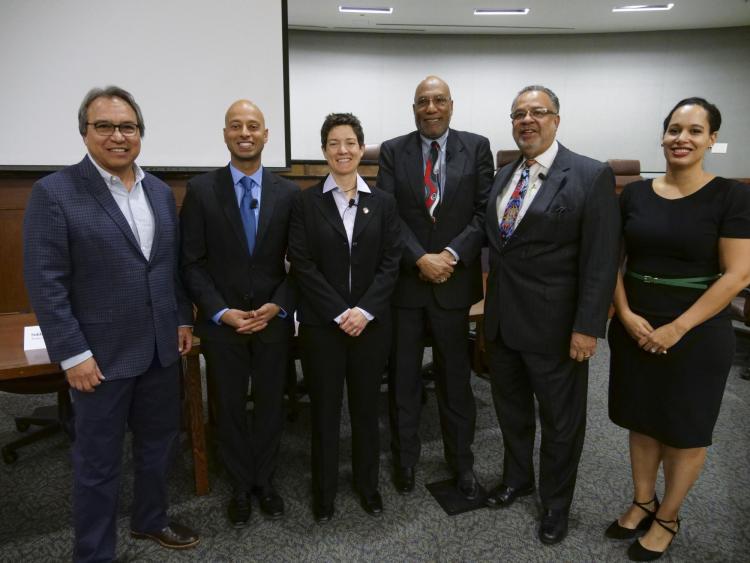
A Feb. 25 panel discussion titled “Lawyers and Judges of Color Balance the Scales” commemorated Black History Month by drawing attention to the contributions of lawyers and judges of color across Colorado and the nation. Co-hosted by the University of Colorado Law School, the Black Law Students Association, and the University of Colorado Boulder’s Office of Diversity, Equity, and Community Engagement, the event provoked discussion about the progress that Colorado and the United States are slowly making in creating a more diverse judiciary and legal field.
Associate Professor Anna Spain Bradley moderated the panel, which featured W. Harold "Sonny" Flowers ('71), attorney with Hurth, Sisk & Blakemore, LLP; Siddhartha H. Rathod (’07), partner at Rathod | Mohamedbhai LLC; Judge Gary Jackson ('70) of the Denver County Court; and Justice Monica M. Márquez of the Colorado Supreme Court. The event opened with remarks from Dean S. James Anaya and an introduction of the panelists by Spain Bradley.
"We are doing a lot, but we have a lot of work ahead, and again, we hope you will join us in this effort," said Márquez, who became the first Latina on the Colorado Supreme Court in 2010. During her time as a justice, she has noticed race and gender imbalances in the judiciary. She explained this imbalance as a leak in the pipeline from Coloradans to attorneys to judges, and shared diversity statistics that reflect the lack of representation of people of color in the judiciary, especially when compared to the racial demographics of Colorado.
Jackson put it a different way: "There are a number of firsts in Colorado that are judges: first brown judge, first black judge, first woman judge, but there are very few seconds and thirds and fourths.” He called attention to the retirement of the only African American district court judge in the state and the upcoming retirement of the only African American judge on the Colorado Court of Appeals. He asked the audience what type of work it would take to increase racial diversity in the judiciary system and challenged the legitimacy of the status quo.
Rathod suggested the following ways to increase diversity in the profession: a commitment to diversity and diversity issues in law schools and higher education institutions; highlighting local attorneys and judges who are advocating for diversity; providing mentorship for law students from minority groups; calling government officials to let them know about judges doing diversity work well; and a commitment to diversity from audience members by joining boards that elect judges, with the intention of considering diverse candidates.
"Nothing in the world moves very fast, even though we want it to," Flowers said. Along with Rathod, Flowers acknowledged that improving diversity in the U.S. legal system will be a slow journey, but a worthy and possible one.
Summarizing the importance of achieving a diverse judiciary, Rathod said, "It’s a representation of our society. We want our society to be reflected in our judges. It causes a diversity of opinion. It causes a more rounded judiciary." Diversity on the bench also shows clients and attorneys of color that they have a "fair shake."
The struggle is equally important, Flowers added. "I have learned that success is measured not so much by the position that one reaches, but rather by the obstacles which one has to overcome while trying to succeed," he said, paraphrasing Booker T. Washington.
Learn more about Colorado Law’s initiatives to further inclusiveness and diversity within the law school and the legal community.
Pictured, left to right: Dean S. James Anaya, Siddhartha Rathod ('07), Justice Monica M. Márquez, W. Harold "Sonny" Flowers ('71), Judge Gary Jackson ('70), and Associate Professor Anna Spain Bradley.


